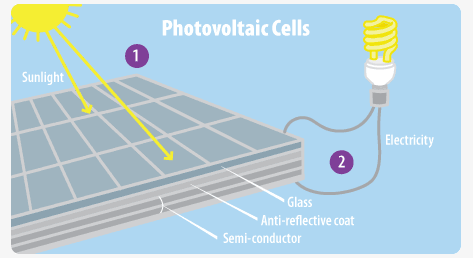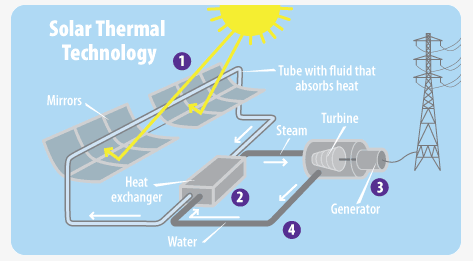Solar Power
While wind energy may still make up the largest portion of California renewables, solar power is increasingly catching up and taking over. At over 13,000 megawatts of solar energy—enough to power 3.3 million homes—California produces more solar electricity than any other state by a wide margin. This is helping to drive a new trend in the national energy scene: more solar was added to the grid in 2015 than natural gas, the previous dominator of new energy.
It’s hard to say exactly what is driving the uptick in solar, but cost is a huge factor. In 2008, installing a solar panel cost around $4 a watt; a year ago it cost $0.74. Today, it costs just $0.65 per watt.
In all the deserved excitement about solar energy, it’s important to remember that not all solar works the same way, or has the same ecological benefit. Broadly speaking, there are two main ways the sun’s rays are turned into electricity: with photovoltaic panels and with solar thermal plants. So what’s the difference?
Photovoltaic Solar
Photovoltaic (PV) solar is what most of us probably picture when we think of solar power: shiny black panels facing the sun. Technically speaking, we are talking about hundreds of little photovoltaic cells being fit together in a stiff, glass-covered panel in order to collect sunlight and transform it into electricity. Here’s an illustration from the Environmental Protection Agency on how that works:

In step one, the sunlight hits the glass and is absorbed by the anti-reflective coating. In step two, the absorbed rays hit the semiconductor and are turned into electricity which can be directly used in a building or put into the electricity grid.
How big these solar panels are and where they go determines what subcategory of solar they are. Photovoltaics can be found in applications as small as your calculator or on areas as large as hundreds of football fields in the desert. Two useful categories, however, are rooftop photovoltaics and large-scale industrial photovoltaics. While each type uses the same technology above, there are different pros and cons to each.
Rooftop PV
Rooftop PV, or rooftop solar, is just what it sounds likes. Rooftop solar is ecologically ideal because it doesn’t disrupt any habitat, but rather makes use of already-built space that would otherwise not go to productive use. From homes to office buildings to casinos, private buildings can put solar panels on their roof to cover part or all of their energy usage. Another “rooftop” options is to build solar paneled canopies over parking lots—protecting cars and producing clean energy at the same time. In most places in California, you can also sell excess solar energy back to the grid utilities company!
While the electricity from the sun is free, it is of course true that installing rooftop solar comes at a cost. However, there are tools in place to make rooftop solar more accessible. Check out these solar tax credits and Google’s Project Sunroof personalized savings calculator to see if rooftop solar might be an affordable option for you.
Large Scale PV
Large scale PV operations can be called a lot of things—solar parks, solar power stations, and solar farms to name a few—but the basic idea is that many large solar panels send electricity into the grid to be distributed by utility companies, rather than to one electricity user specifically like with rooftop solar.
Most often, solar farms are planned for desert areas that receive a lot of sun. Because deserts are not highly hospitable for people, this is also considered—at face value—a beneficial use of land. For conservation, however, where to put large scale solar is a more difficult question. The desert land often targeted for solar development can also be biodiverse desert habitat with key areas for birds, tortoise, lizards and other wildlife.
So what is there to do? The good news is that there is legislation in place to create new solar capacity while minimizing harm to wildlife. The Desert Renewable Energy Conservation Plan (DRECP) will use conservation data to determine where renewable energy like solar should be developed and where to set aside land for conservation. Audubon California advocates designating crucial areas for birds as conservation lands, as well as the general principle of placing solar projects in wildlife-smart locations. This entails:
-
Land that has previously been “mechanically disturbed” with methods such as clear cutting, reservoir drawdown, and scraping.
-
Land that is close to transmission, so that additional infrastructure isn’t necessary.
-
Land that is close to demand, so that less energy is lost in the transport.
Lastly, there is one more thing that we have to look out for with solar farms, and that’s the whether waterbirds or other birds are attracted to solar panels because they perceive them as water bodies (i.e. a “Lake Effect”). Both water bodies and solar panels have reflective surfaces. About 40 per cent of the birds found dead, wounded, or stranded at some solar projects in the desert are water birds and are unable to fly from the ground.
Concentrated Thermal Solar
The other type of solar electricity generation is known as thermal solar or concentrating solar because the plants generate electricity by concentrating solar rays in one spot in order to turn a fluid into steam, which then spins a generator. This process is depicted below.

Unfortunately, not all concentrated thermal solar looks like the diagram above. Some arrange huge number of mirrors to point to a tower in the middle, which can cause big ecological problems.
Concentrated Solar Towers
The problem with concentrating all that solar energy into one place is multi-fold. First, it creates an incredible high-heat area which is dangerous for anything to touch. Second, the light beam and surrounding mirrors attract both birds and their prey (insects). The impact this has on birds can be seen in California’s only concentrated solar tower, Ivanpah.
In 2015, Ivanpah killed an estimated 7.19 birds per gigawatt hour of electricity produced. For comparison, the climate change impacts of burning fossil fuels is estimated to kill only 1 bird per gigawatt hour. Because of this, Audubon California is opposed to any further construction of concentrated solar towers.
Audubon California supports renewable energy when it is sited properly to avoid, minimize or mitigate effectively for impacts on birds, other wildlife and habitat.
How you can help, right now
Get Audubon CA in Your Inbox
Our newsletter is fun way to get our latest stories and important conservation updates from across the state.
Donate to Audubon
Help secure the future for birds at risk from climate change, habitat loss and other threats. Your support will power our science, education, advocacy and on-the-ground conservation efforts.
HOTSPOT: Flyover of California's Birds and Biodiversity
California is a global biodiversity hotspots, with one of the greatest concentrations of living species on Earth.



